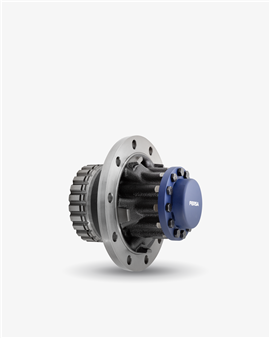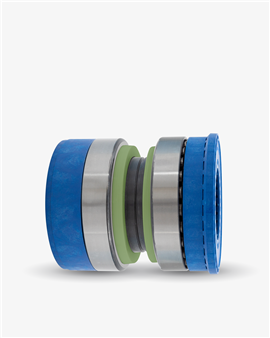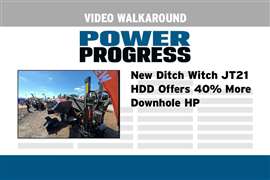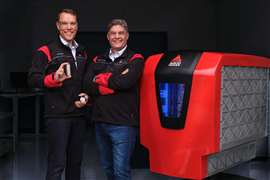Read this article in Français Deutsch Italiano Português Español
Interview: New ‘Fuel Efficient’ wheel hub lowers rolling resistance
08 May 2025
Julian Buckley spoke with David Gimeno from Fersa about the tech used in the company’s new Fuel Efficient wheel hub
 Fuel Efficient wheel hub developed by Fersa (Photo: Fersa)
Fuel Efficient wheel hub developed by Fersa (Photo: Fersa)
Truck engines have undergone some dramatic improvements over the past two decades, with new technologies supporting better fuel economy and reduced CO2 and NOx emissions. But while engine tech has advanced, other elements of heavy-duty powertrains have not benefitted from the same development trajectory.
This is a missed opportunity; while generally delivering smaller overall efficiency gains, factoring out the improved performance of a given component across a large vehicle fleet can deliver significant reductions in fuel usage and emissions.
Fersa has more than 50 years of experience designing and manufacturing complete bearing solutions for vehicles. In March this year, the Spanish company unveiled a new hub intended specifically for medium- and heavy-duty trucks.
Prior to its unveiling, the new Fuel Efficienct (FE) wheel hub had completed more than one million miles of “intensive” testing. Data collected over this period has indicated that the new component can return a 3% – or greater – improvement in fuel economy.
In statement released at launch, Rafael Paniagua, CEO of Fersa, said: “The transportation industry is under immense pressure to reduce both costs and emissions. Our Fuel Efficient technology is a game changer, delivering validated savings on fuel consumption, lower CO₂ emissions and a reduction in drivetrain friction of up to 50%.”
To find out more about the new Fuel Efficient wheel hub, Power Progress International spoke with David Gimeno, Smart Mobility Unit business development manager at Fersa, who started off by giving some more background on the development process.
“About two years ago we noticed that market trends were changing, OEMs were asking for products which were more efficient. We had delivered products which took the working life from one million to two million kilometres, but now the focus was on fuel economy. So we took that unit, which had the two million-kilometre lifespan and asked, ‘what can we do to optimise that design, make it more efficient?’”
“From there we started looking at the wheel hub and what we could do as a bearing company to improve that. It was this investigation which ultimately delivered the Fuel Efficient hub.”
Microgeometry matters
In reimagining the wheel hub, Gimeno explained that some elements are wholly new, while others were carried over. Leveraging the expertise of Fersa, the new hub uses bearings produced using microgeometry equipment which is “totally new” to achieve friction reductions and lower drag.
 One of the trucks used in testing the Fuel Efficient hub (Photo: Fersa)
One of the trucks used in testing the Fuel Efficient hub (Photo: Fersa)
Microgeometry is the fine-scale surface texture affecting contact, friction and functional performance, which in turn means an optimised contact area when individual roller bearings come together. Gimeno said that achieving the necessary level of microgeometry required new machinery, while quality control also had to be stepped up to support the new process.
The steel used to produce the tapered roller bearings was also upgraded to deliver the greater level of microgeometry, while the sealed bearing unit also features an improved lubricant.
“Each of the individual components used to produce the sealed unit are new, they replaced the existing items,” explained Gimeno. “On top of that, we have had a brand new facility constructed to support testing of the components so we can confirm our technology.”
Component production
Fersa produces many of the components used in the Fuel Efficient hubs, including the inner and outer bearing rings, rollers and cages. Gimeno explained that the company is responsible for delivery of the whole bearing. Elements delivered by suppliers include the part castings and lubricants.
“The way this hub has evolved over existing versions means that we must provide all the related components,” he said.
The grease used in the bearing also comes from a trusted supplier; the product is designed to last the lifetime of the complete hub assembly. The sealing process is also new, as it’s critically important that this is sufficiently robust to last the hub’s full working life.
”To meet the necessary tolerances, we made improvements to the material and also the geometry of the seal.”
Economy and emissions
Testing of the new Fuel Efficient hubs showed an average 3% improvement in fuel economy. According to Gimeno, the hubs also delivered lower emissions.
“There is an equation you can use to calculate emissions reduction based on lower fuel economy, the grams of carbon dioxide which are not being emitted. That equation proves that you are reducing emissions.”
 Fersa bearing used in the new hub (Photo: Fersa)
Fersa bearing used in the new hub (Photo: Fersa)
Use of the hub is not limited to diesel models; applied to a battery-electric model, the hubs can help extend overall range. “If the vehicle is using an in-wheel motor system it would need to have some small changes, but if it was an e-drive system delivering power to the wheel in the traditional way, that would work,” said Gimeno.
It would ultimately depend on the drive system – and Fersa has yet to test the unit with a battery-electric truck - but Gimeno believes that the Fuel Efficient hub would successfully manage the torque levels delivered by battery-powered drivetrains. “We have products used in other electrified applications which are working well.”
The hubs can not only be used on truck tractors, but also on the trailers. Gimeno recounted that how, during the testing, the team used two virtually identical trucks (which had number plates which differed by one digit), where one used OE hubs and the other the new FE model.
“We were very pleased with the test results from using the hubs on the tractor units alone. Then we tried using the new hubs on the trailers and we saw a positive impact from those additions,” he noted.
Manufacturing output
As it stands, Fersa is in the “early adoption” phase of launching this new hub. Gimeno stated that the company is working with different customers to understand future demand and from that they will look to put in place manufacturing facilities to support those volumes.
“There are a series of individual components which make up the Fuel Efficient wheel hub,” he explained. “We need to see what demand looks like [before determining final volumes] because the investment to support bearing microgeometry for the hubs is just one application, there will be others.”
POWER SOURCING GUIDE
The trusted reference and buyer’s guide for 83 years
The original “desktop search engine,” guiding nearly 10,000 users in more than 90 countries it is the primary reference for specifications and details on all the components that go into engine systems.
Visit Now
STAY CONNECTED




Receive the information you need when you need it through our world-leading magazines, newsletters and daily briefings.
CONNECT WITH THE TEAM













